Gardening is about more than just planting seeds. It’s about connecting with the earth and understanding how plants grow. When I learned about planting deep, my gardening changed.
Planting deep is not just a trick. It’s a way to make your garden lush and strong. It helps plants grow better and survive tough weather.
Roots are key to a healthy garden. They pull nutrients and keep plants stable. Planting deep gives your plants a strong start.
Experts know that deep planting is the secret to great gardens. This article will show you how to do it. You’ll learn to make your garden amazing.
Are you ready to explore the world of gardening? Your journey to a beautiful garden begins now.
Understanding the Importance of Planting Deep Within
Learning how to plant deep within is key to growing healthy plants. It’s essential whether you’re caring for an indoor plant or building a collection of houseplants. The depth at which you plant affects how well your plants grow.
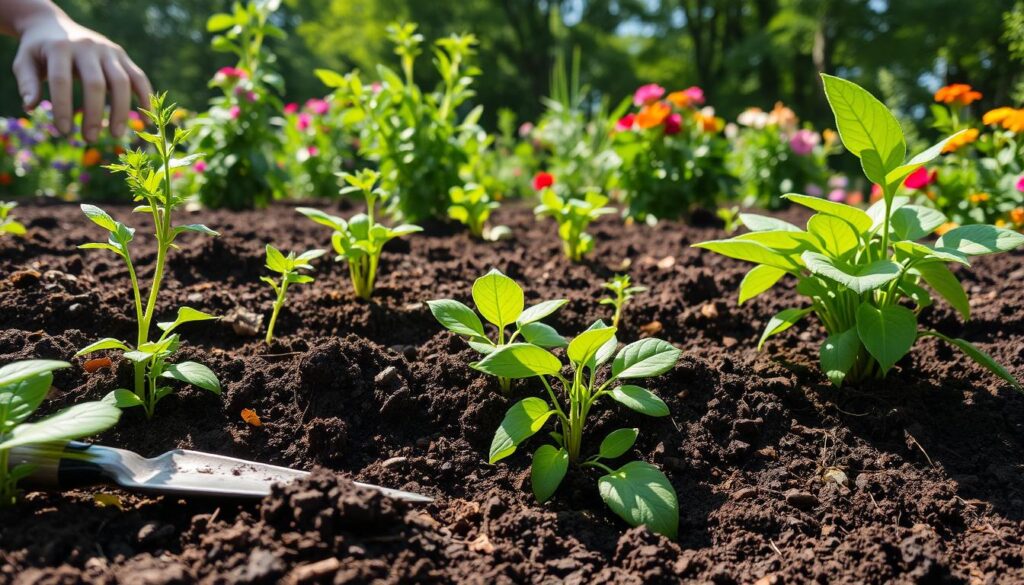
What Does “Plant Deep Within” Mean?
Planting deep within means placing plant roots below the soil’s surface. It’s more than just dropping a plant into the ground. You need to think about the plant’s root structure, the soil, and what each plant needs.
- Allows roots to establish stronger connections with soil nutrients
- Provides better stability for plant growth
- Protects roots from surface temperature fluctuations
Benefits for Plant Growth
Deep planting has many benefits for your plants. It helps roots grow strong, making plants more resilient and healthy. An indoor plant with deep roots can handle environmental changes better and get the nutrients it needs.
Impact on Soil Health
Planting deep within also improves the soil. Deep roots help loosen compacted soil, improve drainage, and create paths for water and air. This makes the soil healthier for all plants.
By using deep planting techniques, you can change how you garden. You’ll give your plants the best start for growing well.
Selecting the Right Plants for Deep Planting
Choosing the right plants for deep planting can make your garden thrive. It’s important to pick plants that grow strong roots. This helps your garden grow well.
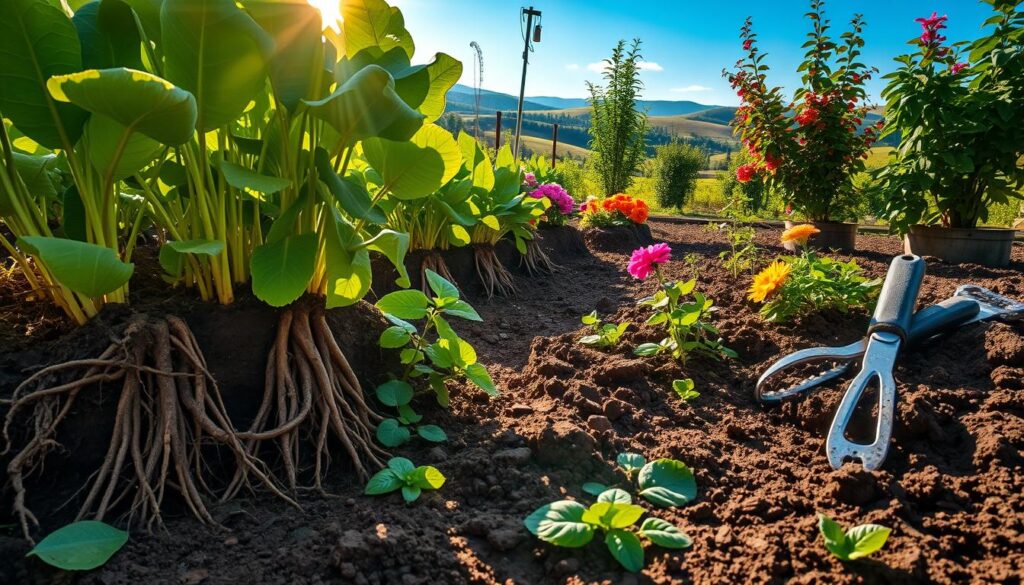
The money plant, also known as Pachira aquatica, is great for deep planting. It’s a Feng Shui plant that looks good and is tough.
Best Plants for Deep Roots
- Pachira aquatica (Money Plant)
- Oak trees
- Lavender
- Rosemary
- Native prairie grasses
Considerations for Soil Type
Soil type affects how plants grow. You need to know if your soil is clay, sandy, or loamy. This helps you choose the right plants for your garden.
| Soil Type | Best Plants | Planting Depth |
|---|---|---|
| Clay Soil | Money Plant, Lavender | 12-18 inches |
| Sandy Soil | Rosemary, Native Grasses | 8-14 inches |
| Loamy Soil | Pachira aquatica | 15-22 inches |
Seasonal Planting Tips
When to plant is key. Spring and early fall are the best times. This lets plants grow strong roots before harsh weather hits.
Deep planting needs patience and the right choice of plants. Each plant adds something special to your garden.
Preparing Your Ground for Deep Planting
Creating the perfect environment for your plants starts with careful ground preparation. When you plant deep within the right soil, you set the stage for easy care plants that will thrive with minimal effort.
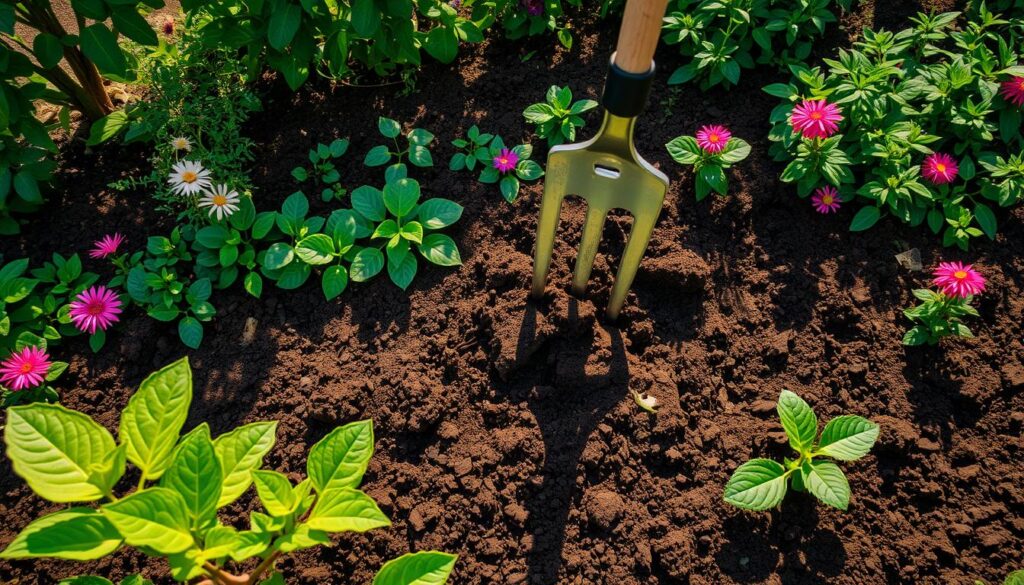
Successful gardening begins with understanding your soil’s unique characteristics. Before you start planting, several critical steps will ensure your plants have the best possible foundation for growth.
Soil Testing Essentials
Knowing your soil’s composition is crucial for plant deep within strategies. Professional soil testing reveals key information about:
- pH levels
- Nutrient content
- Mineral composition
- Drainage capabilities
Essential Planting Tools
To create an ideal planting environment, gather these must-have tools:
| Tool | Purpose |
|---|---|
| Soil pH Test Kit | Measure soil acidity |
| Sturdy Shovel | Digging planting holes |
| Organic Compost | Improve soil nutrition |
| Garden Gloves | Hand protection |
Creating the Perfect Planting Hole
When preparing to plant deep within your garden, follow these crucial steps:
- Clear the area of debris
- Dig a hole twice the width of the plant’s root ball
- Ensure proper depth for root development
- Mix native soil with organic compost
- Gently place the plant, avoiding root damage
By meticulously preparing your ground, you’ll create an ideal environment for easy care plants that will flourish with minimal intervention.
Techniques for Planting Deep Within
Planting deep in your garden needs focus and knowing what each plant needs. This method helps roots grow well and keeps plants healthy.
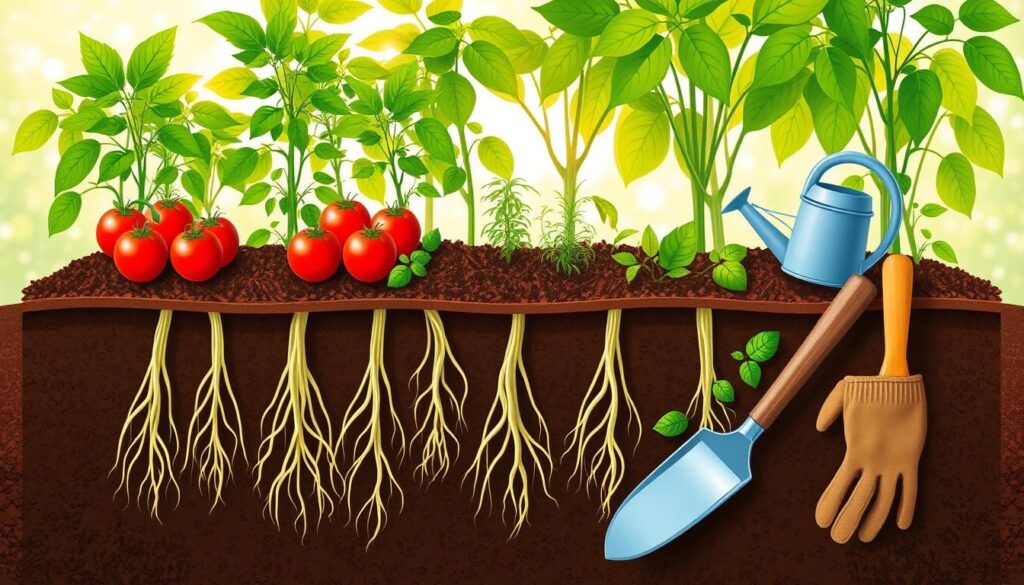
Deep planting is more than just digging a hole. It depends on the plant type and its needs.
Determining the Right Planting Depth
Each plant has its own depth needs to grow well. Here are some tips for deep planting:
- Vegetable plants usually need 6-8 inches of soil
- Air purifying plants often need deeper roots
- Perennial flowers need careful root consideration
Maximizing Soil Nutrition with Mulch and Compost
Mulch and compost are key for deep planting. They add nutrients and keep soil moist, helping plants grow strong.
| Mulch Type | Benefits | Best For |
|---|---|---|
| Organic Mulch | Improves Soil Structure | Most Garden Plants |
| Compost | Adds Nutrients | Air Purifying Plants |
| Wood Chips | Moisture Retention | Trees and Shrubs |
Effective Watering Techniques
Proper watering is key after planting deep. Water slowly and deeply to help roots grow strong. Don’t water just the surface, as it can cause shallow roots.
Using these methods, you’ll make a great place for plants to grow and thrive.
Maintaining Healthy Plants Over Time
To keep your houseplants and easy care plants healthy, you need to pay attention regularly. It’s important to know what they need and create a good environment for them to grow well.
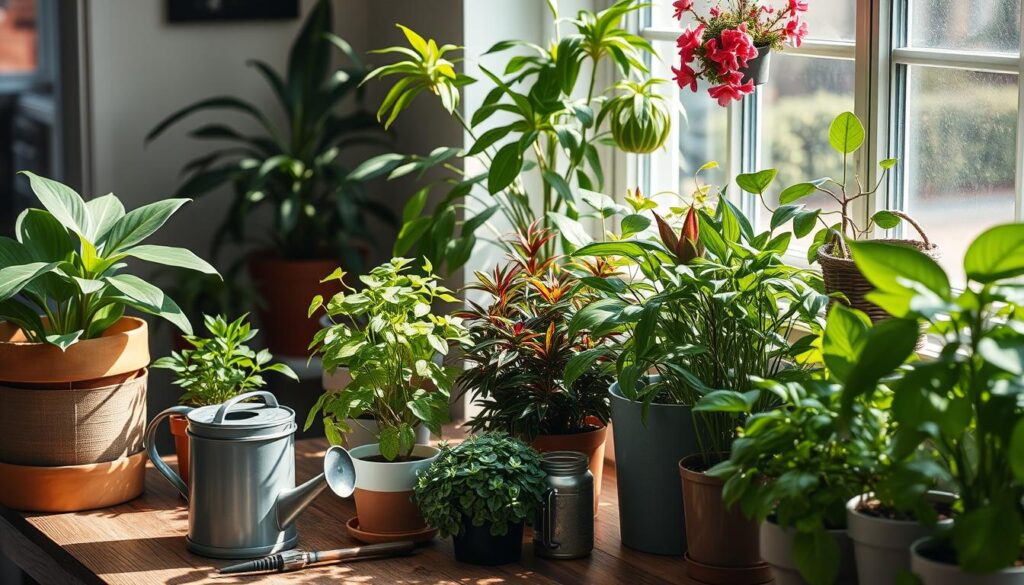
There are a few important steps to keep your plants looking great and strong.
Importance of Regular Watering
Watering is key for any easy care plant. Each plant needs a different amount of water:
- Check soil moisture before watering
- Use room temperature water
- Avoid overwatering by understanding each plant’s specific needs
- Drain excess water to prevent root rot
Feeding Your Plants Nutrients
Good food makes your houseplant grow strong. Choose fertilizers that fit your plant’s needs at different times of the year.
- Use balanced, water-soluble fertilizers
- Apply nutrients during active growth periods
- Follow recommended dosage instructions
Pest and Disease Management
Keeping your plants safe from pests and diseases is crucial. Watch for problems early to stop them from getting worse.
- Inspect plants weekly for signs of infestation
- Isolate infected plants immediately
- Use natural pest control methods when possible
- Maintain clean gardening tools
Remember, consistent care is the cornerstone of a thriving indoor garden.
Common Mistakes in Deep Planting
Cultivating indoor plants needs careful attention. Planting too deep can cause problems. Knowing these issues helps your plants thrive.
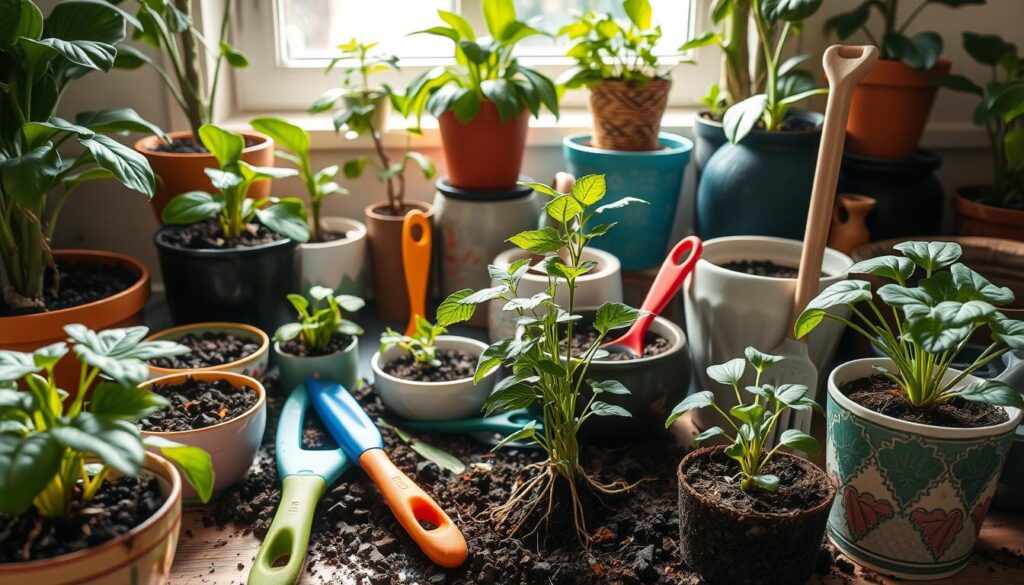
Recognizing Overwatering Warning Signs
Many gardeners struggle with overwatering. Too much water harms indoor plants, causing root rot and decline. Look out for these signs:
- Yellowing leaves
- Soft, mushy stems
- Standing water in the pot
- Fungus or mold on soil surface
Solutions for Water Management
To avoid overwatering, try these tips:
- Use pots with drainage holes
- Check soil moisture before watering
- Use well-draining potting mix
- Water only when top inch of soil is dry
Avoiding Soil Compaction
Soil compaction hurts indoor plants. It blocks root growth, preventing nutrient and water absorption.
| Compaction Signs | Prevention Methods |
|---|---|
| Hard, dense soil | Use perlite or sand in mix |
| Poor drainage | Aerate soil periodically |
| Stunted plant growth | Repot with fresh, loose soil |
Precise Planting Depth Techniques
Getting the plant depth wrong can harm your plants. Different plants need different depths. Research each plant’s needs for the best results in your indoor garden.
Seasonal Care for Deeply Planted Plants
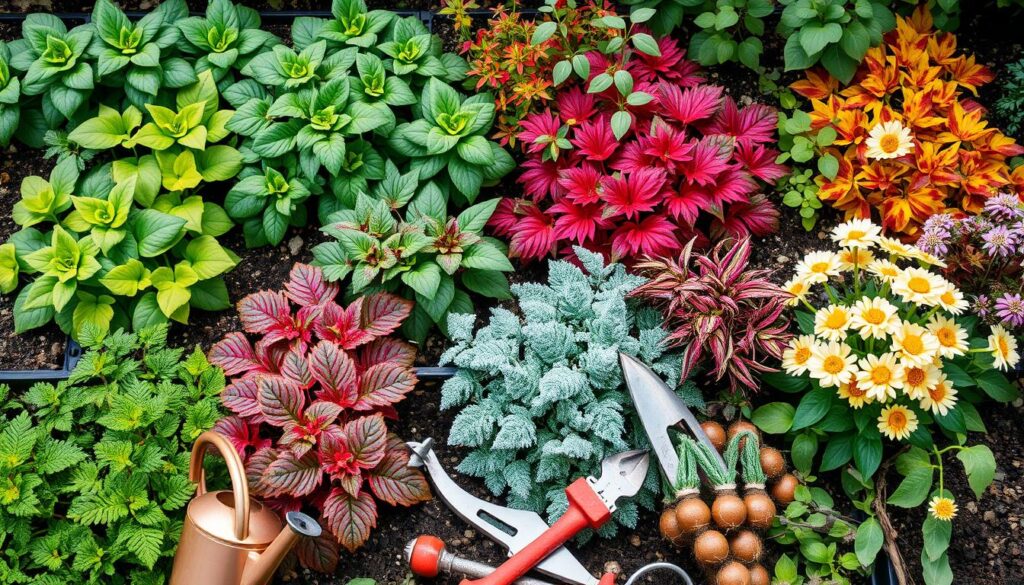
Keeping your plants healthy all year needs careful planning and attention. It’s important to know how each season affects their growth and health. This helps your plants thrive in your garden.
Every season brings its own challenges to your garden. You need to adjust your care to match the changing weather, moisture, and conditions.
Adapting Care Across Seasons
To keep your plants healthy, follow these seasonal tips:
- Spring: Start by gently preparing the soil and adding nutrients slowly.
- Summer: Keep the soil moist and protect from too much sun.
- Autumn: Slowly cut back on watering and prune your plants.
- Winter: Use mulch and do as little as possible to your plants.
Protecting Plants in Harsh Weather
It’s key to protect your plants from extreme weather. Deep-rooted plants are more resilient but still need care.
- Use frost covers when it gets cold.
- Make windbreaks for gardens that get a lot of wind.
- Install drainage to handle heavy rain.
- Give shade when it’s very hot.
Seasonal Fertilizing Tips
Fertilizing is vital for strong plants in your garden. Adjust your fertilizing based on the season’s needs.
- Spring: Use high-nitrogen fertilizers to help plants grow.
- Summer: Use balanced, slow-release nutrients.
- Autumn: Add phosphorus-rich fertilizers for root growth.
- Winter: Don’t fertilize much to avoid stressing your plants.
By following these seasonal care tips, your deeply planted plants will stay healthy and vibrant all year.
Understanding the Role of Roots in Plant Health
Roots are the hidden power of any plant. They are the foundation for growth and health. Planting deep in the soil lets roots spread out, supporting the plant’s health.
The anatomy of plant roots is amazing. Roots are not just simple anchors. They are complex systems that interact with the environment in many ways.
Root Anatomy Explained
- Primary roots: The main vertical root that grows downward
- Secondary roots: Branching roots that extend horizontally
- Root hairs: Microscopic extensions that increase nutrient absorption
How Roots Impact Plant Growth
A plant’s health depends on its roots. Roots do many important things:
- Absorb water and essential nutrients
- Stabilize the plant in the soil
- Store energy and nutrients
- Communicate with soil microorganisms
Techniques for Encouraging Root Development
To plant deep within successfully, try these tips for healthy root growth:
| Technique | Benefits |
|---|---|
| Proper soil preparation | Creates optimal growing conditions |
| Strategic watering | Encourages roots to grow deeper |
| Minimal soil disturbance | Protects delicate root structures |
Knowing about roots helps you grow healthier, stronger plants. These plants can do well in different places.
When to Repot Deeply Rooted Plants
Knowing when to repot your houseplant or indoor plant is key for its health and growth. Repotting gives your plants fresh nutrients and room to grow. It’s a crucial skill for their well-being.
Signs Your Plant Needs Repotting
Look out for these signs that your indoor plant needs a new home:
- Roots growing through drainage holes
- Stunted or slowed growth
- Water runs straight through the pot
- Plant looks visibly larger than its current container
- Roots circling the bottom of the pot
Steps to Successfully Repot
Repotting your houseplant needs a careful approach. Follow these steps for a smooth transition:
- Select a new pot 1-2 inches larger than the current one
- Water the plant 24 hours before repotting
- Gently remove the plant from its current pot
- Loosen the root ball carefully
- Add fresh potting soil to the new container
- Place the plant and fill with additional soil
- Water thoroughly after repotting
Choosing the Right Container Size
Picking the right pot is vital for your indoor plant’s health. Avoid oversized containers that can cause water retention and root rot. The ideal pot should offer enough room for root growth and proper drainage.
Pro tip: Choose containers with drainage holes. Also, terracotta breathes better than plastic, helping prevent overwatering in your houseplant.
The Environmental Benefits of Deep Planting
Deep planting is more than just gardening. It’s a way to help the environment. By planting deep, your garden can become a thriving ecosystem.
Deep planting has a big impact on the environment. It shows how planting can help keep our planet healthy.
Enhancing Soil Quality
Deep roots are key to better soil. When you plant deep, roots:
- Break up hard soil
- Add organic matter
- Make soil better for water
- Lessen soil erosion
Promoting Biodiversity
Air purifying plants with deep roots help many living things. They offer homes and food for tiny creatures and animals.
Carbon Sequestration Through Deep Roots
Deep roots help fight climate change. They store carbon in the ground. An acre of healthy, deeply rooted plants can hold a lot of carbon.
Using deep planting, you help the environment. Your garden becomes a place that supports life.
Case Studies: Successful Deep Planting
Looking at real examples of deep planting shows us amazing gardening ways. These stories teach us and inspire us. They show how careful planting can change gardens for the better.
Gardens That Thrived with Deep Planting
Many gardens have seen big improvements with deep planting. The San Francisco Botanical Gardens used a special Feng Shui plant method. This method made plants healthier and the garden ecosystem better.
- Increased root stability
- Enhanced nutrient absorption
- Improved plant resilience
Lessons Learned from Expert Gardeners
Professional gardeners share key tips for deep planting success:
- Choose plants that fit your soil well
- Know what your plants need for roots
- Make sure your soil has the right nutrients
Community Initiatives Highlighting Deep Planting
Groups in Seattle and Portland are using deep planting in urban gardens. They’re making city spaces greener and more sustainable. This shows how deep planting can change urban areas for the better.
These community efforts prove deep planting is more than a gardening trick. It’s a way for people to work together to care for our planet.
Resources for Further Learning
Your journey into plant deep within techniques doesn’t end here. You can learn more about gardening to make your green spaces thrive. With the right knowledge, even beginners can become confident plant lovers.
Recommended Books and Guides
Check out expert books on advanced planting techniques. “Root Zone Gardening” by Sarah Miller and “The Underground Garden” by Michael Thompson are great choices. They offer detailed insights into deep planting methods.
These books give you practical tips for creating gardens that are both resilient and easy to care for. They help your garden grow strong from the start.
Online Courses and Workshops
Udemy and Coursera have gardening courses to improve your skills. Dr. Emily Rodriguez teaches online workshops on root development and soil health. These sessions are interactive and perfect for gardeners of all levels.
Gardening Communities and Forums
Join online communities like Reddit’s r/gardening or GardenWeb forums. These places are full of advice and tips for gardening. You can share your experiences and learn from others.
FAQ
What does “plant deep within” mean?
Planting deep within means putting a plant’s roots deeper into the soil than usual. This method helps roots grow stronger. It also improves how well the plant absorbs nutrients and stays healthy by giving roots a solid base.
Is deep planting suitable for all types of plants?
No, not every plant does well with deep planting. Some plants, like the Pachira aquatica, have special needs. Always check the specific needs of your plant before trying deep planting.
How deep should I plant my indoor plants?
The right depth for indoor plants varies. Generally, cover the root ball and keep the stem just above the soil. This way, air purifying plants won’t get stem rot.
Can deep planting improve my plant’s Feng Shui properties?
Yes, deep planting can boost a plant’s Feng Shui energy. Plants like the Pachira aquatica, when planted right, can attract wealth. Healthy growth from deep planting makes the plant’s energy and look better.
What are the signs of improper planting depth?
Wrong planting depth can show in stunted growth, yellow leaves, or exposed roots. If too shallow, roots dry out fast. Too deep, and the stem might rot, making it hard for the plant to get nutrients and air.
How often should I repot my deeply rooted plants?
Repot your houseplants every 12-18 months, based on how fast they grow. Watch for signs like roots coming out of holes or the plant slowing down. Choose a slightly bigger pot and use deep planting to help it grow well.
Are there any easy care plants that work well with deep planting?
Yes, plants like snake plants, pothos, and some money plants do great with deep planting. They’re easy to care for and benefit from deep planting, making them perfect for beginners and experts alike.
How does deep planting contribute to environmental benefits?
Deep planting improves soil and supports biodiversity by creating homes for microorganisms. It also helps plants absorb more carbon through their roots. This makes air purifying plants more effective at cleaning the air and improving the environment.




One thought on “Plant Deep Within Unlock the Secret to Vibrant Greenery”